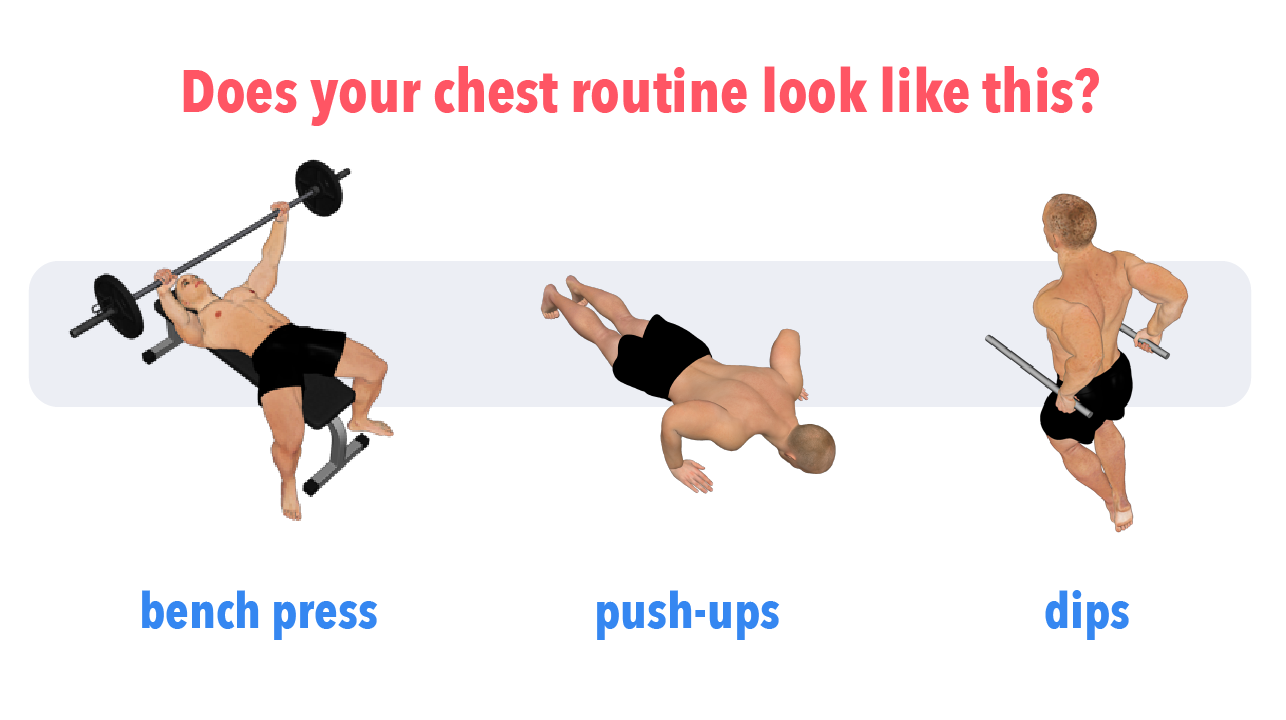Problem Solved: How Often Should You Change Workout Routine?
Stick to your workout routine - and do it for years. Switch it up every single day! Which approach is optimal for maximum muscle growth? We explore here.

There are usually 2 (extreme) camps of lifters: those who find a workout routine they love – and then do that workout every day. Then, some constantly seek novel exercises to 'shock the muscles', believing that this would ultimately lead to better gains ?️♂️
Which approach is correct?
Well… If you're an avid reader of our blog (we see you!), then you'd know that, in general, you don't want to do the same routines at the same intensity every day.
Your body is capable of adapting to the stress you put on it. So, if you’re looking to progress on your fitness journey (i.e. get stronger or build muscle or both), then you’ll have to keep challenging yourself.
This is the principle of progressive overload.

Now, does this mean that you’ll have to emulate Arnold – arguably one of the most prolific bodybuilders around – and seek to ‘confuse’ your muscles? Not exactly.
The truth is that the middle ground is where you’ll see the most muscle gain. But, of course, we’ll get to that in just a bit.
Benefits of varying your exercise routine
First up, though, we still need to convince those whose chest routines look like the following, day-in and day-out for over 5 years:
- Bench press (3x15)
- Push-ups (3x12)
- Dips (4x8)

Please don't feel attacked! You would have undoubtedly seen tremendous gains with this chest routine over the years if you've been progressively overloading (i.e. increasing weight lifted).
But here's the most crucial bit: you're not getting the most out of your workout routine in terms of muscle gain.
Varying your exercise selection is going to make a difference to your physique. Here's why.
1 – Regional hypertrophy
Regional hypertrophy? What?
Regional hypertrophy is simply a scientific term that describes a phenomenon researchers have consistently observed: that different exercises cause growth in different muscle regions.
Let’s bring back the example of your chest routine.
Simply because of your chest's anatomical structure, the cable fly (for instance) is going to grow parts of your pecs well that the bench press doesn't.
That's because the cable fly allows you to bring the arms further back than the bench press allows you to – in turn, enabling you to activate specific motor units and parts of the chest that the latter cannot.
PS: Here are the 3 must-do exercises for a massive chest.

2 – Minimizes wear and tear
The importance of varying your workout routine isn’t just about enhanced muscle growth, though.
There’s also another benefit. And that is: it minimizes the stress that you’re putting on a particular joint or stabilizer muscle.
Imagine only ever using the deadlifts to work your hamstrings!
If the stabilizer muscles around your spine are still fatigued, all that stress is going to shift onto your lower back – and the risk of you getting injured increases exponentially.
Plus, here's the unavoidable truth: you'd need to take a more extended recovery period after doing deadlifts.
That means you'd potentially fail to hit the optimal training volume required for maximum muscle gains.
An easy fix?
Change workout routine workout routine; instead of using deadlifts to target the hamstrings, throw in lying leg curls or even the Nordic leg curls ever so often.
Doing so ensures that you're targeting your hamstrings – but more safely.
3 – Improves adherence to a workout routine
Disclaimer: this might not apply to you if you’re someone who enjoys a predictable, consistent workout routine.
But for most of us, doing the same workout routine for days on end can start to feel a little like eating stale bread… It's not bad per se, but it's not that enjoyable either.
And that's no good since research shows that enjoyment is one of the main reasons people stick to their exercise routine.
The last thing you want to experience is dreading doing a workout because you do it so much. Thankfully, to prevent this from happening, all you need to do is find ways to switch up your routine.
How to vary your workout routine
But… How? Does that mean you’ll have to throw every single exercise you can think of at a particular muscle group (i.e. 8 to 10 exercises per workout) – and hope for the best? Um, please don’t do that.
More is not better in this case.
You’re not going to see more growth from doing more than 3 to 4 exercises per muscle group in a single session. All that additional work you do? It's just 'junk volume.' In other words: it's a case of diminishing returns. Not worth it.
A more reasonable approach to varying your workout routine is to pick 2 to 4 exercises for each of the muscle groups you'd like to target.
You shouldn't just pick based on what you like to do in the gym, of course. Instead, you'll have to gain a deeper understanding of each muscle's anatomy and biomechanical structure – and finally, select exercises that'll target it in a well-rounded manner.
Then, distribute throughout the week as needed.
Depending on how you structure your workout routine, you might end up repeating certain exercises. That's fine, as long as you're not repeating workouts in their entirety.
Don't vary your routine in a thoughtless, haphazard manner!
Whatever you do, please avoid varying your exercise routine just for the sake of it, or worse, simply performing whatever you feel like on that day itself.
That’s because no matter your fitness level, whenever you perform a new exercise, your initial strength gains have a primarily neurological foundation.
In the first few weeks, your motor neurons will have to 'learn' the movement pattern – in turn, 'teaching' your muscles how to lengthen and contract most efficiently.
Meaning all those strength gains you see with a new exercise?
Those are mainly due to your neurological system 'mastering' the movement pattern.
It's only after a few weeks that the bulk of the adaptation will fall onto your muscles; this is where you'll see actual gains.
Ultimately, there’s a science to varying your workout routine for maximum muscle gain in the gym. Overwhelmed?
If you're looking for an app that can guide you in a step-by-step manner on structuring your workouts (while ensuring that you're progressing on your fitness goals), then look no further than GymStreak.
Get GymStreakReferences
Ahtiainen, J. P., Walker, S., Peltonen, H., Holviala, J., Sillanpää, E., Karavirta, L., Sallinen, J., Mikkola, J., Valkeinen, H., Mero, A., Hulmi, J. J., & Häkkinen, K. (2016). Heterogeneity in resistance training-induced muscle strength and mass responses in men and women of different ages. Age (Dordrecht, Netherlands), 38(1), 10. https://doi.org/10.1007/s11357-015-9870-1
Brigatto, F. A., Braz, T. V., Zanini, T. C. da C., Germano, M. D., Aoki, M. S., Schoenfeld, B. J., Marchetti, P. H., & Lopes, C. R. (2019). Effect of Resistance Training Frequency on Neuromuscular Performance and Muscle Morphology After 8 Weeks in Trained Men. Journal of Strength and Conditioning Research, 33(8), 2104–2116. https://doi.org/10.1519/JSC.0000000000002563
Huberty, J. L., Ransdell, L. B., Sidman, C., Flohr, J. A., Shultz, B., Grosshans, O., & Durrant, L. (2008). Explaining long-term exercise adherence in women who complete a structured exercise program. Research Quarterly for Exercise and Sport, 79(3), 374–384. https://doi.org/10.1080/02701367.2008.10599501
Lundberg, T. R., García-Gutiérrez, M. T., Mandić, M., Lilja, M., & Fernandez-Gonzalo, R. (2019). Regional and muscle-specific adaptations in knee extensor hypertrophy using flywheel versus conventional weight-stack resistance exercise. Applied Physiology, Nutrition, and Metabolism = Physiologie Appliquee, Nutrition Et Metabolisme, 44(8), 827–833. https://doi.org/10.1139/apnm-2018-0774


